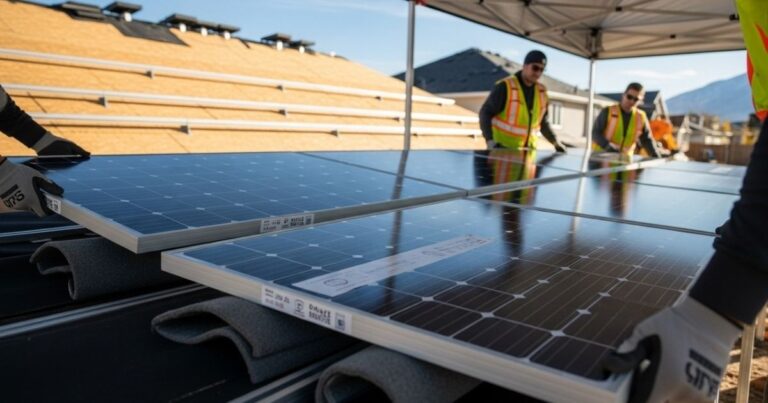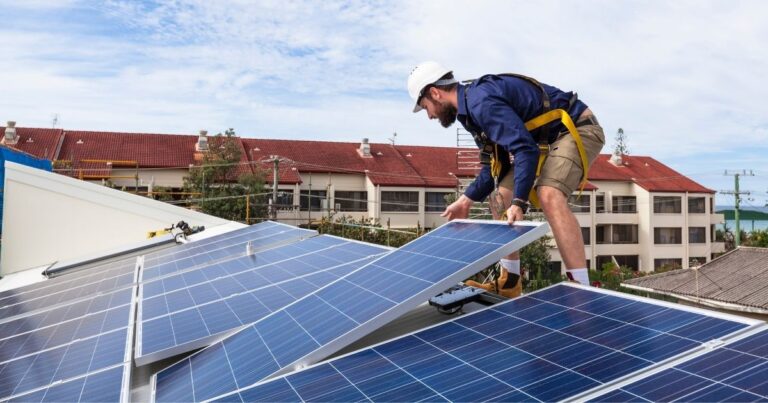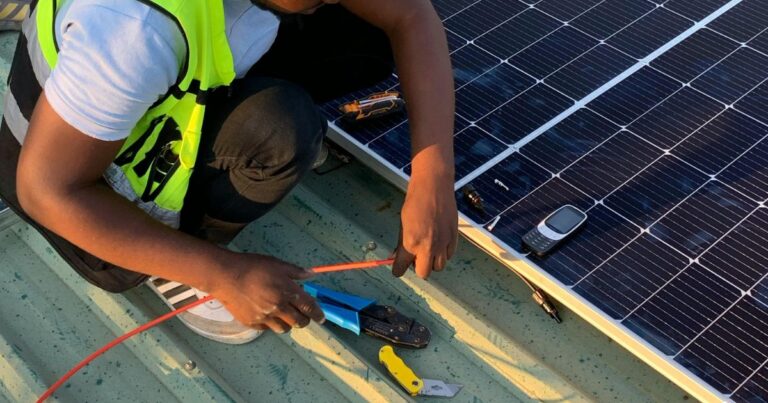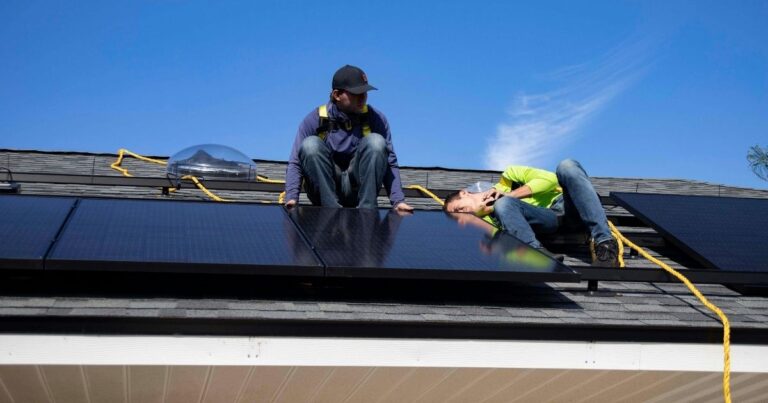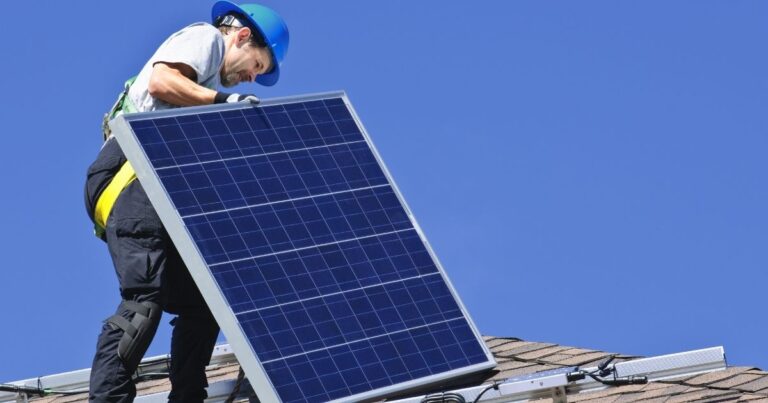How to Remove Solar Panels Safely for Roof Work
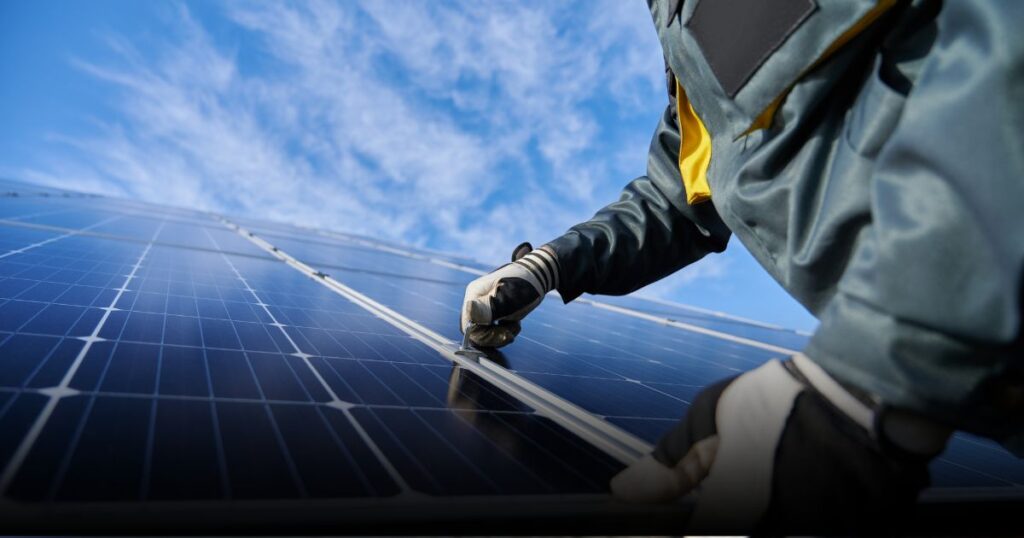
If your roof needs repairs or replacement and you have a solar system installed, one of the first questions that comes up is how to remove solar panels without causing damage or voiding your warranty. While the process may sound straightforward, handling solar equipment incorrectly can create costly risks for homeowners, contractors, and insurance teams alike.
In this guide, you’ll learn:
- Why solar panels need to be removed during roof work
- The risks of DIY or unqualified removal
- The step-by-step process professionals follow
- What affects the cost of removal and reinstallation
- Who should actually handle the job
- How insurance and storm claims factor in
- Why hiring a licensed, local specialist matters
This article will give you a clear, trustworthy overview of the process so you can protect your investment, avoid project delays, and know exactly what to expect when your roof work involves solar panels.
First, let’s look at why solar panels need to be removed during roof work.
Why Solar Panels Need to Be Removed During Roof Work
If your roof needs to be repaired or replaced, your solar panels can’t simply stay in place. To access the shingles, underlayment, and structural layers of the roof, contractors need a clear surface to work on. Leaving panels attached puts both the roof and the solar system at risk.
Think of it like renovating a kitchen—you wouldn’t replace the flooring with all the appliances bolted down. In the same way, roofing work requires solar panels to be safely removed first, then reinstalled once the roof is complete.
There are three main reasons why professional removal is essential:
- Roof Access and Safety – Roofers cannot properly strip, repair, or replace materials with solar panels in the way. Attempting to work around them can lead to incomplete repairs or damage to the system.
- Protecting Your Investment – Solar panels are a major investment. Improper handling can crack glass, damage wiring, or reduce system performance — requiring solar panel repair later. Professional removal ensures your panels are safely detached, stored, and reinstalled without harm—protecting your solar investment during roof replacement.
- Warranty and Insurance Compliance – Most solar manufacturers require panels to be removed and reinstalled by trained professionals to keep warranties intact. Insurers also expect proper documentation of removal and reset when claims involve storm or hail damage.
Homeowners in Northern Utah often face this situation after a decade or more of roof wear—or sooner if hail or wind causes damage. Skipping removal or trusting an unqualified team can create more problems than it solves, including voided warranties, denied claims, and costly system repairs.
Key takeaway: Before any roofing project, panels must be carefully removed by specialists offering solar panel removal. It’s the only way to ensure the roof is repaired correctly, the solar system is protected, and warranties remain valid.
The Risks of DIY or Unqualified Solar Panel Removal
When faced with a roof repair or replacement, it might be tempting to try and remove solar panels yourself—or ask your roofer to handle it. After all, it seems like it’s just a matter of unbolting and lifting, right? Unfortunately, it’s not that simple. Solar systems are complex electrical setups, and handling them without the right training can create serious and expensive problems.
Here’s what can go wrong when removal isn’t done by a qualified specialist:
Voided Warranties – Most solar panel and inverter manufacturers require panels to be detached and reinstalled by certified professionals. If an untrained person touches the system, you risk losing manufacturer warranty coverage on equipment that was designed to last 20+ years.
Electrical Hazards – Even when disconnected from the grid, solar panels generate electricity when exposed to sunlight. Improper handling can cause dangerous electrical shocks and safety hazards that put both people and property at risk.
Damage to Panels or Roof – Panels are heavy, fragile, and interconnected. A dropped panel, pinched wire, or cracked seal during removal can reduce system performance—or worse, cause leaks in the new roof.
Will Removing Solar Panels Void My Warranty?
This is one of the most common concerns homeowners have, and the answer depends on who does the work. If a licensed, trained specialist follows manufacturer-approved methods, your warranty remains intact. If a roofer, handyman, or homeowner attempts removal, the warranty is often voided immediately.
That’s why safe solar panel reinstallation by a qualified team isn’t just a best practice—it’s a requirement for protecting both your roof and your energy system.
Key takeaway: DIY removal may save a little time upfront, but the risks—warranty loss, electrical hazards, and costly damage—far outweigh the short-term convenience. Hiring a professional is the only way to ensure manufacturer warranty compliance and peace of mind.
How Professionals Remove and Reset Solar Panels (Step-by-Step)
Removing solar panels for roof work isn’t just about taking them off and putting them back on later. A professional team follows a careful, structured process designed to protect your equipment, maintain manufacturer warranty compliance, and ensure your system works exactly as it should once the roof is complete. Here’s what that looks like in practice:
- Step 1 – Documentation & System Inspection
Before anything is removed, the solar system is carefully inspected and documented. Technicians note the panel layout, wiring connections, and system performance. This creates a reference point for reinstalling the system correctly later and provides valuable records for insurance or warranty purposes. - Step 2 – Safe Detach & Labeling
Each panel is detached using manufacturer-approved methods. Wires, connectors, and mounting hardware are clearly labeled to avoid confusion during reinstallation. This “solar detach and reset” process ensures that when the panels go back up, every connection is restored exactly as it was designed. - Step 3 – Panel Storage & Protection
Once removed, panels are stored in a safe, secure location—either on-site or off-site—depending on the project. Proper padding and stacking methods prevent scratches, cracks, or electrical damage, which is critical when storing solar panels during roof work. Think of this step like moving fine glassware: careful handling and storage are non-negotiable. - Step 4 – Professional Reinstallation & System Testing
After the roof work is complete, the panels are reinstalled using the documented plan via solar panel reinstallation. Technicians secure mounting hardware, reconnect wiring, and perform a full system inspection to confirm everything is working safely and efficiently. This step also ensures safe solar panel reinstallation that meets both manufacturer and warranty requirements.
Key takeaway: A professional detach and reset service isn’t just panel removal—it’s a start-to-finish process that safeguards your system at every stage. By following these steps, specialists ensure your panels are protected, your warranty remains valid, and your solar power is back online as quickly as possible.
How Much Does It Cost to Remove Solar Panels?
One of the first questions homeowners ask is: “What’s the cost to remove solar panels for roof replacement?” The answer isn’t the same for everyone—it depends on several factors. While exact pricing requires a custom quote, understanding what affects cost will help you set realistic expectations.
Key Factors That Influence Cost
- System Size and Complexity
Larger systems with more panels take longer to remove and reinstall. Additional components like inverters or battery storage can add steps to the process. - Storage Needs
Panels may be stored safely on-site (like in a garage) or off-site if space is limited — this is part of our solar panel storage solution. Storage solutions vary in cost depending on the method used. - Roof Design and Condition
Steeper or more complex roof structures require extra time and safety precautions. Older roofs may need additional prep to avoid damage during removal. - Insurance and Claim Involvement
If roof work is tied to storm damage or a claim, costs may be partially or fully covered as part of insurance-approved solar panel removal.
Documentation and compliance are critical here to ensure reimbursement.
Cost vs. Risk Savings
At first glance, professional removal may seem like an added expense. But when compared with the risks—like voiding a warranty, damaging panels, or delaying a roofing project—the value becomes clear. Attempting a DIY removal or hiring someone unqualified can lead to thousands of dollars in repairs or replacements.
Key takeaway: The cost of professional removal is an investment in protecting your solar system, your roof, and your warranty. In nearly every case, the long-term savings and peace of mind far outweigh the upfront price.
Who Actually Removes the Panels? (Roofer vs. Solar Specialist)
It’s a common point of confusion: when your roof needs work, shouldn’t your roofer just handle the solar panels too? The reality is that most roofing contractors are not trained or insured to work with solar systems. Their expertise lies in shingles, underlayment, and structural repair—not high-voltage equipment and delicate solar hardware.
In fact, many roofers will specifically state that they cannot touch your panels. Doing so could expose them to liability if something goes wrong, from electrical hazards to warranty disputes. This leaves homeowners stuck in the middle—roofers can’t move forward, and the project stalls until a qualified solar subcontractor support team steps in.
That’s where a specialist like SwiftSolar D&R comes in. Acting as a subcontractor for roofing and solar coordination, we take the solar burden off the roofer’s shoulders. By handling all aspects of removal, storage, and reinstallation, we provide roofing contractor solar support that keeps projects moving on schedule.
The benefit for roofers is clear: no liability, no risk, and no delays. For homeowners, it means panels are safely removed and reinstalled without voiding warranties. For insurance teams, it ensures the project is properly documented and compliant. In short, professional specialists deliver liability-free solar panel removal for roofers and peace of mind for everyone involved.
Key takeaway: Your roofer should focus on your roof. A licensed solar detach and reset specialist should handle the panels—working together to ensure the job gets done safely, efficiently, and without unnecessary risk.
Solar Panel Removal in Insurance and Storm Damage Claims
In Northern Utah, hail, high winds, and heavy snow can take a serious toll on roofs, often leading to premature repairs or replacements. When storm damage occurs, insurance claims often cover the cost of roof replacement or repair—but if you have solar panels, they must be removed before work can begin. Leaving panels in place risks further damage, delays the claim, and complicates the restoration process.
That’s why insurers and restoration contractors rely on specialists. Professional solar detach and reset ensures panels are handled safely, warranties remain valid, and the project can move forward without unnecessary setbacks.
Claim Documentation & Accuracy
Insurance companies require detailed proof of every step in a claim. A solar removal specialist provides claim documentation for solar panel removal, including before-and-after photos, system performance checks, and clear records of reinstallation. This not only protects the homeowner but also helps adjusters process claims smoothly and justify costs with confidence.
Working With Adjusters & Restoration Teams
Storm restoration projects often involve tight deadlines and multiple contractors working together. SwiftSolar D&R coordinates directly with adjusters and roofing teams to keep timelines on track. Whether it’s storm and hail damage restoration with solar or routine roof repairs tied to an insurance claim, having a trusted solar partner prevents delays and reduces stress for everyone involved.
Key takeaway: In storm or hail damage claims, solar panel removal isn’t optional—it’s a critical part of the process. With proper documentation, warranty protection, and seamless coordination, specialists keep claims moving and homeowners protected.
Why Choose a Licensed, Warranty-Safe Specialist in Northern Utah
When it comes to solar panel removal, not all providers are the same. Choosing a licensed solar panel removal company in Utah makes the difference between a project that runs smoothly and one that turns into a costly headache.
As Northern Utah solar service specialists, SwiftSolar D&R focuses exclusively on detach and reset services—nothing else. That means no competing priorities, no upselling, and no divided attention. Our entire process is designed around fast, safe, and warranty-compliant panel handling that keeps your roofing or insurance project on track.
Here’s why that matters:
- Local Expertise – We understand the unique roofing challenges in Northern Utah, from hailstorms to heavy snow loads. Our team is based here and works directly with local roofers and adjusters.
- Warranty Compliance – We follow manufacturer-approved methods, ensuring your solar investment stays protected long after the roof is complete.
- Fast Turnaround – Roofing and insurance projects run on tight timelines. We’re responsive and ready, so you don’t have to worry about delays.
- Seamless Collaboration – Whether coordinating with your roofing contractor or working alongside your insurance adjuster, we integrate smoothly into the process so you don’t have to play middleman.
By working with a dedicated specialist, you get peace of mind knowing your roof will be replaced correctly and your solar system will be restored to full performance—without the risk of voided warranties or drawn-out claims.
Key takeaway: If you need panels removed for roof work or storm repairs, choose a licensed, local expert who specializes only in solar detach and reset. In Northern Utah, that’s SwiftSolar D&R.
Conclusion – Safe, Stress-Free Solar Panel Removal
Removing solar panels for roof work isn’t something to take lightly. DIY attempts or unqualified handling can lead to damaged equipment, electrical hazards, and even voided warranties. On the other hand, professional detach and reset services protect your investment, keep roofing projects on schedule, and ensure insurance claims move forward without delays.
For homeowners, that means peace of mind knowing your system is in safe hands. For roofing contractors, it means liability-free support and smoother workflows. And for insurance adjusters, it ensures accurate documentation and warranty compliance every step of the way.
At SwiftSolar D&R, we specialize exclusively in solar panel detach and reset. With local expertise, fast turnaround, and a focus on warranty-safe methods, we’re the trusted partner for homeowners, contractors, and insurance teams across Northern Utah.
Ready to make your roofing project simple and stress-free? Get a Free Quote Today or call us to schedule your detach and reset.
Frequently Asked Questions About Solar Panel Removal
Solar panels should always be removed by a licensed solar detach and reset specialist—not by the roofer or homeowner. Specialists have the training, equipment, and insurance to handle panels safely, protect your warranty, and ensure the system is reinstalled correctly.
Most roofers are not trained or insured to work on solar systems. While they’re experts at roofing, handling electrical equipment and delicate panels requires a solar professional. A specialist ensures liability-free solar panel removal for roofers, so the roof can be replaced without added risks.
The cost to remove solar panels for roof replacement depends on factors like system size, roof complexity, and whether panels need temporary storage. Insurance may also cover part or all of the cost if storm damage is involved. A professional quote is the best way to know your exact price.
In many cases, yes—if the roof damage is related to a covered peril such as hail or wind. Insurance-approved solar panel removal is often included in storm or restoration claims, but proper documentation is key. Always confirm coverage with your adjuster and work with a specialist who can provide accurate records.
While the panels are detached, your solar system won’t produce electricity. Once the roof work is complete, specialists will reinstall and test the system to bring it back online. Temporary downtime is normal, but professional reinstallation ensures your system runs at full performance again.

